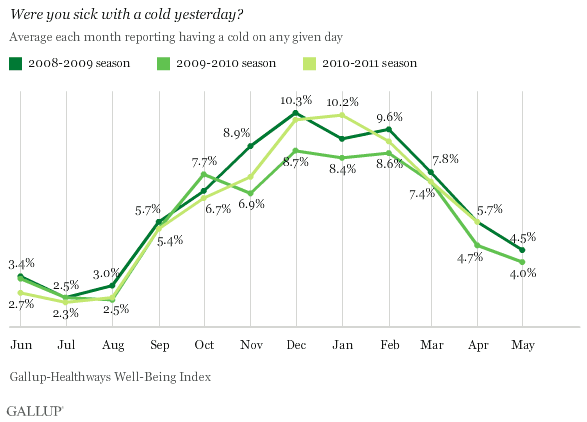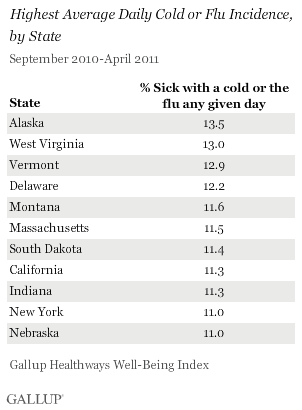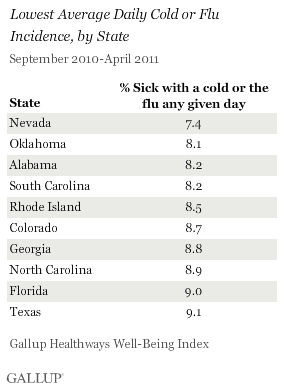WASHINGTON, D.C. -- More American adults reported having the flu in April this year than did so in the same month last year, the fifth consecutive month in which monthly flu reports exceeded those from last season. Flu reports peaked in February, which is typical, at 3.3%, higher than the 2.2% in the same month last year.

American adults' self-reports of the flu, however, were lower throughout the start of this flu season -- in September, October, and November -- than they were last season.
By asking 1,000 Americans each day whether they had the flu "yesterday," the Gallup-Healthways Well-Being Index data provide a clear picture of the prevalence of flu throughout the course of the season and compare the findings with previous seasons.
Cold Reports Higher in Most Months This Year
Nearly 6% of American adults reported having a cold in April this year, up from 4.7% in April 2010. More Americans reported having a cold in most months this year than did so last year, although all three years of measurement have trended similarly.

Measuring self-reports of colds vs. the flu can be complex because of the overlapping symptoms of the two disease conditions and many Americans' misunderstanding of what symptoms constitute "the flu" versus "a cold." Still, the opportunity for year-over-year comparisons provides useful insight into the self-reported prevalence of each. In general, roughly three times as Americans report having a cold "yesterday" than report having the flu.
Alaska, West Virginia Have Highest Reports of Colds and Flu
Americans living in Alaska, West Virginia, and Vermont were the most likely across states surveyed to report daily colds and flu this season, with about 13% of residents in each state reporting being sick with either on any given day. In contrast, 7.4% of Nevadans reported either of these conditions on average each day.


Residents of cold weather climates are probably more susceptible to getting sick with the flu as they spend more time indoors in the winter, increasing their opportunity to catch the virus. Cooler weather also creates more favorable conditions for the virus to survive in nature, which also increases the chances that someone will actually get sick. These factors likely play a role in increasing reports of the cold and flu in the winter months, and why warmer weather states tend to have lower rates of colds and the flu than their colder weather counterparts.
Bottom Line
Many factors have likely played a role in the higher levels of the flu and colds this season. While the ease and availability of combined H1N1/influenza vaccinations were greater this year, other more practical efforts to curtail the spread of the flu -- and, by association, colds as well -- may have declined as a result of a reduced sense of urgency. The schools and community public health officials that undertook significant efforts to encourage conscientious hygiene practices last year -- when there was widespread fear of contracting H1N1 -- were perhaps less aggressive in their messaging and communication plans this season. Without such large-scale prevention campaigns, Americans may have become more complacent about protecting themselves against the flu and colds. This illustrates the potential impact that public health policy and preventative health education can have on subsequent health outcomes.
About the Gallup-Healthways Well-Being Index
The Gallup-Healthways Well-Being Index tracks U.S. and U.K. well-being and provides best-in-class solutions for a healthier world. To learn more, please visit well-beingindex.com.
Survey Methods
Results are based on telephone interviews conducted as part of the Gallup-Healthways Well-Being Index surveys each day, with a random sample of 1,000 adults, or roughly 30,000 adults per month, aged 18 and older, living in all 50 U.S. states and the District of Columbia, selected using random-digit-dial sampling.
For results based on the total sample of national adults, one can say with 95% confidence that the maximum margin of sampling error is ±0.6 percentage point.
The margin of sampling error for most states is ±1 to 2 percentage points, but is as high as ±4 percentage points for smaller states such as Wyoming, North Dakota, South Dakota, Delaware, and Hawaii.
One of the questions asked each day is, "Were you sick with any of the following yesterday?" The question specifies four illnesses: the flu, a cold, a headache, and allergies. Respondents are not asked to indicate whether they had received a clinical diagnosis of H1N1 or other types of influenza via a healthcare professional.
Interviews are conducted with respondents on landline telephones and cellular phones, with interviews conducted in Spanish for respondents who are primarily Spanish-speaking. Each daily sample includes a minimum quota of 400 cell phone respondents and 600 landline respondents, with additional minimum quotas among landline respondents for gender within region. Landline respondents are chosen at random within each household on the basis of which member had the most recent birthday.
Samples are weighted by gender, age, race, Hispanic ethnicity, education, region, adults in the household, cell phone-only status, cell phone-mostly status, and phone lines. Demographic weighting targets are based on the March 2010 Current Population Survey figures for the aged 18 and older non-institutionalized population living in U.S. telephone households. All reported margins of sampling error include the computed design effects for weighting and sample design.
In addition to sampling error, question wording and practical difficulties in conducting surveys can introduce error or bias into the findings of public opinion polls.
For more details on Gallup's polling methodology, visit https://www.gallup.com/.
